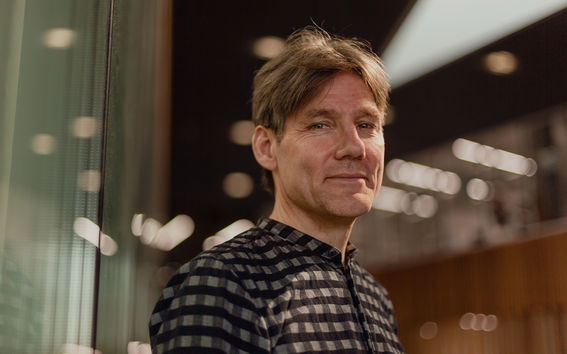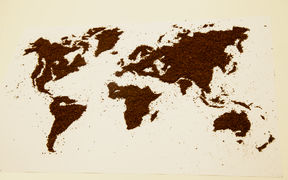'The way we spend our time makes a big difference'

'I believe that self-sufficiency and do-it-yourself activities go hand in hand. For me, this goes back to an overall view of industrialisation, which started pretty much in the late 18th century, and brought about the obvious concerns we have now about natural resource use and pollution of different kinds. Pollution is basically the overloading of nature and the overloading of nature's capacity to absorb toxins and other forms of waste.
Industrialisation brought this about, but at the same time it goes together with urbanization and with increasing specialization of professions and so forth. What we have emerging through industrialization is a society that is highly organized and increasingly concentrated in cities. This also includes the specialization of professions, meaning each one of us increasingly specializes in something we get paid for, and then we use our purchasing power and the markets to get what we need. The metabolism of society has changed so that the global supply of resources and nodes of consumption are separated from both the origins of materials and also most of the consequences of resource use. In an extreme sense, you could say people are starting to live in a kind of hotel-like existence, relying on others for the provision of their basic needs. The only thing that is left is to work in your narrow profession and to consume.
It is a terminal image of the development of industrialization and specialization.
Services economy versus ownership economy
A lot of the sustainability-related discussions are quite clear about the overloading of nature and so forth, but most are not clear at all concerning these aspects of specialization and urbanization. Quite the contrary: many claim that we need further urbanization and denser cities to be able to provide public transportation and efficient energy services.
One corollary of a rise in specialization is the increase of services offered. The rhetoric at the moment is that people don't need to own anything anymore, they can just rent the services when needed. It's being framed as an environmental issue, and of course if done correctly it can bring about some gains in efficiency. With private cars this is obvious: on average, families use their car an hour or so per day. Why should it make sense to have one's own car if you only need it for an hour?
But at the same time, mobility as a service represents ownership being transferred to companies from private individuals. Someone else owns the means of production and property, and we are reduced more and more to the role of consumers. Urbanism and capitalism go well together in this sense, and people in cities increasingly rely on the provision of services.
In financial terms, the greatest assets people still own, and here Finland is high up on the list, is home and apartment ownership. From that perspective, we still have a population that is not only consuming services but also owning important economic assets themselves. And home ownership brings us around to the next point, repair and maintenance.
Community and capital
Self-sufficiency, do it yourself, maintenance and repair: all these things rely on skills and typically also require capital assets of a certain kind. For people to be self-sufficient, they have to possess enough to grow and produce their own food or energy. Whether it is then an efficient use of resources for people to own their own equipment, and to repair and maintain it, is a different question and depends on the perspective. Certainly not with all goods: shared ownership of automobilies makes much more sense, actually.
Self-sufficiency is not by nature individualistic. You can have communities that share assets, from real estate to automobiles. Before we had commercial car sharing schemes, there were lots of private arrangements where people would share a car.
We may be experiencing a sort of renaissance of skill valuation, at least the conspicuous display of certain skills on social media. People are proud to be able to do things like fix their bike or grow their own food: these kind of activities are not self evident anymore. But the general view is that the skill base is declining. Our generation and the ones following it are much more consume-oriented than the previous generation.
As long as our tax system remains as it is, repair culture will have difficulties growing very much. Repair is very labour intensive, and by nature is more distributed than production. It is impossible to have the same level of centralization as with first-stage production.
Mikko Jalas, Creative sustainability Programme DirectorWe encourage students to explore different approaches to address issues relating to energy, consumption and sustainability.
Time use
Personally, I have been looking at this question from a time-use perspective. I've been thinking about the ways we use our time: which activities are the least harmful, which are the most environmentally destructive ways for us to spend our time. Because the way we spend our time on an individual level makes a big difference.
Many repair and maintenance activities take a great deal of time and effort: you have to develop your skills, and you have to find the materials to maintain and repair goods. These type of activities become something of a way of life, so you start to organize other parts of your life around them, from where and how you live, to skills and tools you acquire, etc. To some extent, the whole way you live begins to support your repair activities.
Studying time use leads me to claim that if you are doing these kinds of activities, you are likely not doing other, more harmful activities, and that probably has an environmental benefit. Patterns of life can be constructed around low-impact DIY and repair activities.
It also relates to where we started: the labour market and specialization. Repair and maintenance are ways of trying to reduce the cost of living and instead using your own time and skill. They also run against the grain to the trend of specialization. It all goes together with work time reduction, for example.
Politics and self-sufficiency
When large companies control the whole supply chain, they often introduce closed designs. That might mean screws that don't work with normal tools, no compatibility of replacement parts or software, for example. An iPhone by Apple is a good example of a closed design.
When you think about a bicycle, it is precisely the opposite. Parts are manufactured by different companies and someone then just puts the bicycle together. There are existing standards that basically allow anyone to easily buy parts and change things around. We all own bikes, so the entire industry is open to the degree that it's easy to design a new bicycle model because you just buy the existing parts and assemble them in a different way.
If we ask how governments can act against this kind of closure, and enable repair and maintenance on products, there is no easy answer. For example in the auto industry: there have been regulations requiring manufacturers to take back the old products. From an environmental standpoint, this seems to be unequivically positive. But for small car repair and maintenance workshops, this type of regulation can mean an end to their business of disassembling and repairing cars, because they will not get access to old vehicles. For commercial car manufacturers, this kind of regulation is likely to increase business, because it prevents the sale of secondary parts and shortens the lifecycle of automobiles.
This is another example of how certain circular economy measures of 'closing the loop' and forcing manufacturers to be more responsible for the afterlife of their products actually contributes to an economy where things might be circulating quickly, but it is not a society of maintenance and repair.
Energy production and self-sufficiency
There are a lot of things people can do on their own. Some require more space than others. I've been involved in wind turbine energy generation for a long time, over 20 years now. We set up a company that operates industrial-scale turbines, but is owned by private households. It is not a cooperative, but a limited liability company that issues shares, each share entitling the bearer to buy electricity from the company.
The electricity is delivered through the national power grid, and the families are scattered throughout Finland. We have one annual meeting where finances and the annual report are discussed, but there is very little community besides that. Nevertheless, I believe this is a type of self-sufficiency: the company provides opportunities for people to invest in wind power and acquire a share in a wind turbine so they can have secure energy prices and be in control of their own power supply.
Recently I have been thinking about small-scale wind power. I used to think that industrial scale wind turbines make more sense, because they are much cheaper to build and more efficient. But small-scale wind turbines are very interesting as well.
We held a workshop from 6 to 9 June in Väre, led by Kostas Latoufis, a Greek man who has been doing research at intentional communities and ecovillages on a wind turbine model dating from the 1970s. The design is very basic: you start with commercially available parts. For example, the main bearing of the turbine is a commercially available trailer bearing, and the rest is made of simple metal products that are readily available. The blades are built of wood, which still seems odd to me. There are several diameters of the turbine. We build a 2.4-diameter turbine, which is relatively small, a single-occupancy house supply unit.
A new approach to business and built environment
In the Creative Sustainability programme, we encourage students to explore different approaches to address issues relating to energy, consumption and sustainability. Not only in theory: students create projects on hydroponics, plastic recycling and urban farming, to name just a few initiatives. This spring, we piloted a course 'Innovative approach to circular economy' as part of Sitra's module on Circular economy, art and cultural change.'
***
Finland presents its exhibition Everyday Experiments at the XXII Triennale di Milano, featuring twelve experimental projects people are already doing to make their lives more sustainable and equitable. La Triennale di Milano will take place from 1 March to 1 September 2019 and is curated by Paola Antonelli, Senior Curator of Architecture and Design and Director of Research & Development at The Museum of Modern Art. Broken Nature will reflect on the relationship between humans and environments at all scales—from the microbiome to the cosmos—including social, cultural, and natural ecosystems.
Learn more about all 12 Everyday Experiments: everdayexperiments.aalto.fi
The XXII Triennale, Broken Nature: http://www.brokennature.org/
Innovative Approach to Circular Economy
Aalto University's innovative pilot course studied the circular economy, arts and systemic changes.

Read more news

Your voice gives away valuable personal information, so how do you keep that data safe?
With speech technologies becoming increasingly common, researchers want to make sure we don’t give away more information than we mean to.
Aalto in 2025: Quantum leaps, creative breakthroughs and solutions for a better life
Growth, technology and industrial renewal; human-centred solutions; health and everyday wellbeing; and enjoyable daily life and thriving communities.
Research Council of Finland establishes a Center of Excellence in Quantum Materials
The Centre, called QMAT, creates new materials to power the quantum technology of coming decades.






